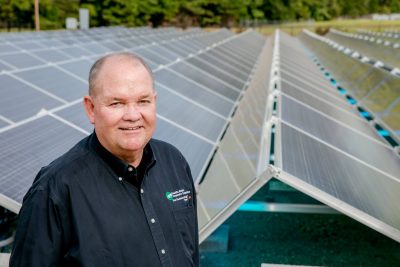Front Porch Blog
By Clarisse Hayle – TN Energy Savings Outreach and Communications Assistant 2018

Ouachita Electric Cooperative General Manager Mark Cayce. Photo courtesy of Ouachita Electric Cooperative
Based in Camden, Arkansas, Ouachita Electric Cooperative is a shining light in the world of rural electric co-ops. The utility has gone above and beyond to implement cleaner and more efficient energy production and other programs that aim to improve quality of life for members. Breaking barriers left and right, Ouachita serves as a model for other cooperatives seeking progress and and innovation in the industry.
Making Energy Easier
With their Pay-As-You-Save (PAYS©) program, Ouachita gives its member-owners the opportunity to improve the energy efficiency of their homes and lower their energy bills. Through this program, the cooperative will cover any new appliances and insulation the home needs with no up-front costs to the member. Instead, the member pays a small charge on their monthly utility bill, called a tariff, in order to pay the cooperative back for its investment.
Even with this additional tariff, the bill is lower than it was before due to all the energy saved from the new installations. Because there are no loans or credit-checks, three times as many members are benefitting from Ouachita’s new PAYS© model as opposed to the old loan-based efficiency program. Each member also gets to keep around 20 percent of the money they saved on the new utilities bill. Instead of spending money on energy bills, now that money can be used for other things like groceries and health care. To make things even more exciting for Ouachita members, General Manager Mark Cayce announced at the 2018 Rural Energy Conference that “starting in November of this year, we’re gonna include home solar as part of our PAYS© program.”
Solar Powers Forward
Ouachita also worked hard to bring energy efficiency to local schools by installing new lighting and mini-split heating and air systems. This saved the schools about $17,000 each per year on their energy bills.
Moving forward with solar energy could change the community drastically. According to Cayce, the installation of solar was an uphill battle. Ouachita’s engineering team had their doubts, saying that it wouldn’t work in Arkansas. The cooperative went against their advice and dove in head first by installing a solar field at their headquarters to supply 92 percent of the office’s energy needs. By implementing solar, utility expenses for their office went down.
“The more we invested, the more we saved,” Cayce said at a recent conference on rural energy in Atlanta, Ga.
One of the biggest issues in rural areas is keeping people in the area instead of having them leave for jobs in the city.
“In the past twenty years we’ve had steady population decline,” says Cayce, “and we think energy efficiency and solar is bringing that back.”
The numbers back his word. Aerojet Rocketdyne Holdings, the company that bought Camden’s 12-megawatt solar array, has seen an increase in the number of people it employs since the implementation of solar. Aerojet previously had 800 employees, but after the solar array went online in 2016, that number has jumped to 1200 with an additional 150 job openings on the way.
“What an exciting time it is to be in utilities,” Cayce remarked.
All of this energy is coming at a lower cost to Aerojet, which means that Ouachita is making less money off of energy. It seems counterproductive; why would any utility supplier want to sell energy at a lower price and decrease their profit? “Well,” says Cayce, “We’re in the business of serving our members, not selling electricity.”
Connecting a Nation
While solar was an ambitious step forward, Ouachita didn’t stop there. In rural communities, access to the internet has been a problem. Trends show that rural areas are lagging behind in both speed and accessibility to the internet.
“We had a lot of people that would live in our territory but couldn’t because they couldn’t work from home because they didn’t have internet connection,” says Cayce. “People from our area didn’t really know what Netflix was.”
Ouachita is working to counteract this problem with ARIS High Speed Fiber Internet. ARIS is a joint company formed by Ouachita Electric Cooperative and South Arkansas Telephone that aims to bring up to 1GB internet speeds to the 9,500 homes of all Ouachita members. That’s ten times the normal speed offered by area cable companies. This is a great help to schools and businesses in the service area.
“The idea is that by combining energy efficiency and solar and high speed internet, we can make a formula for success in the future and it’s bringing growth back to our part of the world,” concludes Cayce.
So far it seems to be working well for Ouachita. Jobs are growing and people are saving money on their utility bills. Despite the all the previous setbacks, Ouachita continues supporting cleaner energy.
Only one uncertainty remains. If Ouachita can do it, why aren’t more rural electric cooperatives taking the same initiatives?
PREVIOUS
NEXT
Related News

Leave a comment
Your email address will not be published. Required fields are marked *


After reading the article I feel like I just drank a cup full of sugar. So 12 MWs of solar power created 550 new jobs for the business referenced? A generation source that works 25% of the time is an economic engine and job creator? I am not seeing this at all. I know we are all intoxicated with renewable energy but remember these old poles, wires and generation plants need to be paid for. The easiest thing to do is create a kWh and the hardest thing to do is deliver it 24/7. The comment “we are in the business of serving our members and not selling electricity” reads well but Ouachita is going to need money to pay for their considerable fixed cost and that will come directly from the members.
Very Interesting blog on app voices. Please keep sharing. Thanks for your Information.